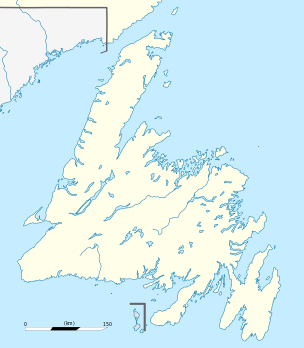Lawn, Newfoundland and Labrador
| Lawn, Newfoundland and Labrador | |
|---|---|
 Location of Lawn in Newfoundland | |
| Coordinates: 46°56′N 55°33′W / 46.933°N 55.550°W | |
| Country | Canada |
| Province | Newfoundland and Labrador |
| Population (2011) | |
| • Total | 672 |
| Time zone | Newfoundland Time (UTC-3:30) |
| • Summer (DST) | Newfoundland Daylight (UTC-2:30) |
| A0E2E0 | A0E2E0 |
| Area code(s) | 709 |
| Website | www.townoflawn.com 9 currently down |
Lawn, population approximately 670 as of 2011, is located at the tip of the Burin Peninsula on Newfoundland's South coast, Newfoundland and Labrador. Lawn is spread around a small harbor in a relatively lush valley. According to one local tradition it was this lushness that inspired Captain James Cook to name the place Lawn Harbor. But it has also been speculated that a Frenchman named the community after a doe caribou that he spotted there.
Lawn is a community whose survival over the past two hundred years has depended entirely on the fishery. The abundance of fish in the waters surrounding Lawn (formerly known as Laun) attracted seasonal fishermen from France, Portugal, Spain and England. These fishermen came over in large fishing ships and returned to their homelands in the fall. This type of migratory fishery continued to exist on the Burin Peninsula well into the eighteen hundreds. However, in 1763 an important event occurred which had a tremendous impact on the development of permanent settlements on the Burin Peninsula. The town of Lawn was formed as Community Council in 1952 and was changed to a Town Council in 1968.
Early history
Prior to 1763 the English and French were continually at war with each other. These wars took a toll on both nations, as they fought for control of various colonial possessions. Newfoundland, with its abundant supply of fish, became a colonial prize, which both nations fought over. The two nations agreed to divide the island into two zones in which they were permitted to prosecute a summer fishery. The Burin Peninsula was part of the “French Shore” in which the French had exclusive fishing rights. In the 1760s the British gained the upper hand in their war with France and finally in 1763 the French were defeated.
In 1763 the French signed the Treaty of Utrect, which forced them to abandon all territorial claims on the island of Newfoundland. The only possessions they were permitted to keep were the islands of St. Pierre and Miquelon. The Banishment of the French made permanent settlement much more attractive in Burin Peninsula communities such as Lawn.
The first settlers to establish permanent residence in Lawn were the Connors (O’ Connor) family who came from County Cork, Ireland. Michael and his brother Peter Connors were fish merchants who decided to stay in Lawn after the summed fishery. Many of these workers began to spend their winters in lawn and eventually married women from nearby communities. The Connors, Murphy, Strang, Pike and Tarrant descendants planted family roots, which have survived to this very day.
The survival of Lawn in the late seventeen hundreds and early eighteen hundreds were influenced by two important factors. The most important factor was the supply of cod. The second factor was the availability of a market for the cod. In the late 18th century the Sir Robert Newman Company that was one of the most powerful fishing establishments in Newfoundland, set up a business in St. Lawrence. This gave some sense of stability to the area and provided easy access to a market for fisherman from Lawn. The Sir Robert Newman Company also helped bring young men over from England and Ireland to work in the fishery. This along with the prosperous fishery made Lawn a very viable fishing settlement.
1942 tragedy
In the predawn hours of February 18, 1942, three United States Navy ships ran aground on the shore of the Burin Peninsula between Lawn and the nearby community of St. Lawrence. It was determined that the USS Pollux, USS Truxtun and USS Wilkes made a navigation error while en route to Naval Station Argentia. Eight residents of Lawn assisted in the rescue of survivors. 185 sailors survived and 203 died as a result of the disaster.
See also
Coordinates: 46°56′N 55°33′W / 46.933°N 55.550°W